An Advanced Echo Separation Scheme for Space-Time Waveform-Encoding SAR Based on Digital Beamforming and Blind Source Separation
Abstract
:1. Introduction
2. Problem Formulation
2.1. Conventional Echo Separation Scheme
2.2. Influence of Elevation Error on Conventional Echo Separation Scheme
3. Echo Separation Scheme
3.1. Blind Source Separation Model
- (1)
- De-average:
- (2)
- Whiten:
- (3)
- Calculate the covariance matrix:
- (4)
- Calculate the orthogonal matrix:
- (5)
- Separate source signals:
3.2. Proposed Scheme
- (1)
- Echoes received by all sub-apertures in elevation are weighted by two vectors denoted by rows of ;
- (2)
- The outputs of vetors are weighted by the corresopnding elements in and combined to extract the echo signals from the k th sub-pulse.
- (1)
- The echo signal matrix after the LCMV processing is a matrix of size , where , denote the number of azimuth and range sampling points, respectively. Then, the echo signal matrix is stretched into a row vector signal, and the mixed signal matrix is formed.
- (2)
- Apply BSS to the mixed signal matrix and process it: de-averaging, whitening, solving the unitary matrix and joint diagonalization, as shown in Section 3.
- (3)
- Restore the separated signals to signal matrices by rows.
4. Simulation
4.1. Point Target Simulation
4.2. Distributed Target Simulation
5. Conclusions
Author Contributions
Funding
Data Availability Statement
Acknowledgments
Conflicts of Interest
References
- Demirci, Ş.; Özdemir, C. An investigation of the performances of polarimetric target decompositions using GB-SAR imaging. Int. J. Eng. Geosci. 2021, 6, 9–19. [Google Scholar] [CrossRef]
- Duysak, H.; Yiğit, E. Investigation of the performance of different wavelet-based fusions of SAR and optical images using Sentinel-1 and Sentinel-2 datasets. Int. J. Eng. Geosci. 2022, 7, 81–90. [Google Scholar] [CrossRef]
- Yiğit, E.; Demirci, Ş.; Özdemir, C. Clutter removal in millimeter wave GB-SAR images using OTSU’s thresholding method. Int. J. Eng. Geosci. 2022, 7, 43–48. [Google Scholar] [CrossRef]
- Moreira, A.; Krieger, G.; Hajnsek, I.; Papathanassiou, K.; Younis, M.; Lopez-Dekker, P.; Huber, S.; Villano, M.; Pardini, M.; Eineder, M.; et al. Tandem-L: A highly innovative bistatic SAR mission for global observation of dynamic processes on the Earth’s surface. IEEE Trans. Geosci. Remote Sens. 2015, 3, 8–23. [Google Scholar] [CrossRef]
- Gebert, N.; Krieger, G.; Moreira, A. Digital beamforming on receive: Techniques and optimization strategies for high-resolution wide-swath SAR imaging. IEEE Trans. Aerosp. Electron. Syst. 2009, 45, 564–592. [Google Scholar] [CrossRef] [Green Version]
- Zhou, Y.; Wang, W.; Chen, Z.; Zhao, Q.; Zhang, H.; Deng, Y.; Wang, R. High-resolution and wide-swath SAR imaging mode using frequency diverse planar array. IEEE Geosci. Remote Sens. Lett. 2020, 18, 321–325. [Google Scholar] [CrossRef]
- Zhang, S.X.; Xing, M.D.; Xia, X.G.; Zhang, L.; Guo, R.; Liao, Y.; Bao, Z. Multichannel HRWS SAR imaging based on range-variant channel calibration and multi-Doppler-direction restriction ambiguity suppression. IEEE Trans. Geosci. Remote Sens. 2013, 52, 4306–4327. [Google Scholar] [CrossRef]
- Krieger, G.; Younis, M.; Gebert, N.; Huber, S.; Bordoni, F.; Patyuchenko, A.; Moreira, A. Advanced concepts for high-resolution wide-swath SAR imaging. In Proceedings of the 8th European Conference on Synthetic Aperture Radar, VDE, Aachen, Germany, 7–10 June 2010; pp. 1–4. [Google Scholar]
- Freeman, A.; Johnson, W.T.; Huneycutt, B.E.A.; Jordan, R.; Hensley, S.; Siqueira, P.; Curlander, J. The “Myth” of the minimum SAR antenna area constraint. IEEE Trans. Geosci. Remote Sens. 2000, 38, 320–324. [Google Scholar] [CrossRef] [Green Version]
- Zhang, Y.; Wang, R.; Wang, W.; Deng, Y. An Innovative Multiswath Jump Imaging Mode for Spaceborne SAR. IEEE Geosci. Remote Sens. Lett. 2020, 18, 1219–1223. [Google Scholar] [CrossRef]
- Zhou, Y.; Wang, R.; Deng, Y.; Yu, W.; Fan, H.; Liang, D.; Zhao, Q. A novel approach to Doppler centroid and channel errors estimation in azimuth multi-channel SAR. IEEE Trans. Geosci. Remote Sens. 2019, 57, 8430–8444. [Google Scholar] [CrossRef]
- Currie, A.; Brown, M.A. Wide-swath SAR. IEE Proc. F-Radar Signal Process. 1992, 139, 122–135. [Google Scholar]
- Currie, A. Wide-swath SAR imaging with multiple azimuth beams. In Proceedings of the IEE Colloquium on Synthetic Aperture Radar, IET, London, UK, 29 November 1989; pp. 3/1–3/4. [Google Scholar]
- Callaghan, G.; Longstaff, I. Wide-swath space-borne SAR and range ambiguity. In Proceedings of the Radar Systems (RADAR 97), Edinburgh, UK, 14–16 October 1997. [Google Scholar]
- Süß, M.; Grafmüller, B.; Zahn, R. A novel high resolution, wide swath SAR system. In Proceedings of the IGARSS 2001, Scanning the Present and Resolving the Future, Proceedings IEEE 2001 International Geoscience and Remote Sensing Symposium (Cat. No. 01CH37217), Sydney, NSW, Australia, 9–13 July 2001; Volume 3, pp. 1013–1015. [Google Scholar]
- Krieger, G.; Gebert, N.; Moreira, A. Multidimensional waveform encoding: A new digital beamforming technique for synthetic aperture radar remote sensing. IEEE Trans. Geosci. Remote Sens. 2007, 46, 31–46. [Google Scholar] [CrossRef] [Green Version]
- Zhang, Y.; Han, S.; Wei, T.; Wang, W.; Deng, Y.; Jin, G.; Zhang, Y.; Wang, R. First Demonstration of Echo Separation for Orthogonal Waveform Encoding MIMO-SAR Based on Airborne Experiments. IEEE Trans. Geosci. Remote Sens. 2022, 60, 5225016. [Google Scholar]
- Zhao, Q.; Zhang, Y.; Wang, W.; Deng, Y.; Yu, W.; Zhou, Y.; Wang, R. Echo separation for space-time waveform-encoding SAR with digital scalloped beamforming and adaptive multiple null-steering. IEEE Geosci. Remote Sens. Lett. 2020, 18, 92–96. [Google Scholar]
- Zhou, Y.; Li, J.; Zhang, H.; Chen, Z.; Zhang, L.; Wang, P. Internal Calibration for Airborne X-Band DBF-SAR Imaging. IEEE Geosci. Remote Sens. Lett. 2021, 19, 4008105. [Google Scholar] [CrossRef]
- Qiu, J.; Zhang, Z.; Wang, R.; Wang, P.; Zhang, H.; Du, J.; Wang, W.; Chen, Z.; Zhou, Y.; Jia, H.; et al. A novel weight generator in real-Time processing architecture of DBF-SAR. IEEE Trans. Geosci. Remote Sens. 2021, 60, 5204915. [Google Scholar] [CrossRef]
- Qiu, J.; Zhang, Z.; Chen, Z.; Han, S.; Wang, W.; Wen, Y.; Meng, X.; Fan, H. A Novel Real-Time Echo Separation Processing Architecture for Space–Time Waveform-Encoding SAR Based on Elevation Digital Beamforming. Remote Sens. 2022, 14, 213. [Google Scholar] [CrossRef]
- Zhou, Y.; Wang, W.; Chen, Z.; Wang, P.; Zhang, H.; Qiu, J.; Zhao, Q.; Deng, Y.; Zhang, Z.; Yu, W.; et al. Digital beamforming synthetic aperture radar (DBSAR): Experiments and performance analysis in support of 16-channel airborne X-band SAR data. IEEE Trans. Geosci. Remote Sens. 2020, 59, 6784–6798. [Google Scholar] [CrossRef]
- He, F.; Ma, X.; Dong, Z.; Liang, D. Digital beamforming on receive in elevation for multidimensional waveform encoding SAR sensing. IEEE Geosci. Remote Sens. Lett. 2014, 11, 2173–2177. [Google Scholar]
- Wang, S.; Sun, Y.; He, F.; Sun, Z.; Li, P.; Dong, Z. DBF processing in range-doppler domain for MWE SAR waveform separation based on digital array-fed reflector antenna. Remote Sens. 2020, 12, 3161. [Google Scholar] [CrossRef]
- Feng, F.; Li, S.; Yu, W.; Huang, P.; Xu, W. Echo separation in multidimensional waveform encoding SAR remote sensing using an advanced null-steering beamformer. IEEE Trans. Geosci. Remote Sens. 2012, 50, 4157–4172. [Google Scholar]
- Krieger, G.; Huber, S.; Villano, M.; Younis, M.; Rommel, T.; Dekker, P.L.; de Almeida, F.Q.; Moreira, A. CEBRAS: Cross elevation beam range ambiguity suppression for high-resolution wide-swath and MIMO-SAR imaging. In Proceedings of the 2015 IEEE International Geoscience and Remote Sensing Symposium (IGARSS), Milan, Italy, 26–31 July 2015; pp. 196–199. [Google Scholar]
- Ward, C.; Hargrave, P.; McWhirter, J. A novel algorithm and architecture for adaptive digital beamforming. IEEE Trans. Antennas Propag. 1986, 34, 338–346. [Google Scholar]
- Steyskal, H. Digital beamforming. In Proceedings of the 1988 18th European Microwave Conference, Stockholm, Sweden, 12–15 September 1988; pp. 49–57. [Google Scholar]
- Wang, X.; Chen, C.; Jiang, W. Implementation of real-time LCMV adaptive digital beamforming technology. In Proceedings of the 2018 International Conference on Electronics Technology (ICET), Chengdu, China, 23–27 July 2018; pp. 134–137. [Google Scholar]
- Glentis, G.O. A fast algorithm for APES and Capon spectral estimation. IEEE Trans. Signal Process. 2008, 56, 4207–4220. [Google Scholar]
- Weber, R.J.; Huang, Y. Analysis for Capon and MUSIC DOA estimation algorithms. In Proceedings of the 2009 IEEE Antennas and Propagation Society International Symposium, North Charleston, SC, USA, 1–5 June 2009; pp. 1–4. [Google Scholar]
- Cox, H.; Zeskind, R.; Owen, M. Robust adaptive beamforming. IEEE Trans. Audio Speech Lang. Process. 1987, 35, 1365–1376. [Google Scholar]
- Friedlander, B. A sensitivity analysis of the MUSIC algorithm. IEEE Trans. Audio Speech Lang. Process. 1990, 38, 1740–1751. [Google Scholar] [CrossRef]
- Kundu, D. Modified MUSIC algorithm for estimating DOA of signals. Signal Process. 1996, 48, 85–90. [Google Scholar]
- Belouchrani, A.; Abed-Meraim, K.; Cardoso, J.F.; Moulines, E. A blind source separation technique using second-order statistics. IEEE Trans. Signal Process. 1997, 45, 434–444. [Google Scholar]
- Naik, G.R.; Wang, W. Blind Source Separation; Springer: Berlin/Heidelberg, Germany, 2014; Volume 10, pp. 973–978. [Google Scholar]
- Kitamura, D.; Ono, N.; Sawada, H.; Kameoka, H.; Saruwatari, H. Determined blind source separation with independent low-rank matrix analysis. In Audio Source Separation; Springer: Berlin/Heidelberg, Germany, 2018; pp. 125–155. [Google Scholar]
- Pu, W. Shuffle GAN with autoencoder: A deep learning approach to separate moving and stationary targets in SAR imagery. IEEE Trans. Neural Netw. Learn. Syst. 2021, 1–15. [Google Scholar] [CrossRef]
- Chang, S.; Deng, Y.; Zhang, Y.; Zhao, Q.; Wang, R.; Zhang, K. An Advanced Scheme for Range Ambiguity Suppression of Spaceborne SAR Based on Blind Source Separation. IEEE Trans. Geosci. Remote Sens. 2022, 60, 5230112. [Google Scholar] [CrossRef]
- Huber, S.; Younis, M.; Patyuchenko, A.; Krieger, G.; Moreira, A. Spaceborne reflector SAR systems with digital beamforming. IEEE Trans. Aerosp. Electron. Syst. 2012, 48, 3473–3493. [Google Scholar]
- Xu, J.; Liao, G.; Zhu, S.; Huang, L. Response vector constrained robust LCMV beamforming based on semidefinite programming. IEEE Trans. Signal Process. 2015, 63, 5720–5732. [Google Scholar]
- Huber, S.; Younis, M.; Patyuchenko, A.; Krieger, G. Digital beam forming techniques for spaceborne reflector SAR systems. In Proceedings of the 8th European Conference on Synthetic Aperture Radar, VDE, Aachen, Germany, 7–10 June 2010; pp. 1–4. [Google Scholar]
- Van Veen, B.D.; Van Drongelen, W.; Yuchtman, M.; Suzuki, A. Localization of brain electrical activity via linearly constrained minimum variance spatial filtering. IEEE Trans. Biomed. Eng. 1997, 44, 867–880. [Google Scholar] [PubMed]
- Roy, R.; Kailath, T. ESPRIT-estimation of signal parameters via rotational invariance techniques. IEEE Trans. Audio Speech Lang. Process. 1989, 37, 984–995. [Google Scholar]
- Comon, P.; Jutten, C. Handbook of Blind Source Separation: Independent Component Analysis and Applications; Academic Press: Cambridge, MA, USA, 2010. [Google Scholar]
- Raney, R.K.; Runge, H.; Bamler, R.; Cumming, I.G.; Wong, F.H. Precision SAR processing using chirp scaling. IEEE Trans. Geosci. Remote Sens. 1994, 32, 786–799. [Google Scholar]
- Moreira, A.; Mittermayer, J.; Scheiber, R. Extended chirp scaling algorithm for air-and spaceborne SAR data processing in stripmap and ScanSAR imaging modes. IEEE Trans. Geosci. Remote Sens. 1996, 34, 1123–1136. [Google Scholar]
- Li, C.; Zhang, H.; Deng, Y.; Wang, R.; Liu, K.; Liu, D.; Jin, G.; Zhang, Y. Focusing the L-band spaceborne bistatic SAR mission data using a modified RD algorithm. IEEE Trans. Geosci. Remote Sens. 2019, 58, 294–306. [Google Scholar]
- Hore, A.; Ziou, D. Image quality metrics: PSNR vs. SSIM. In Proceedings of the 2010 20th International Conference on Pattern Recognition, Istanbul, Turkey, 23–26 August 2010; pp. 2366–2369. [Google Scholar]
- Pu, W. SAE-net: A deep neural network for SAR autofocus. IEEE Trans. Geosci. Remote Sens. 2022, 60, 5220714. [Google Scholar]



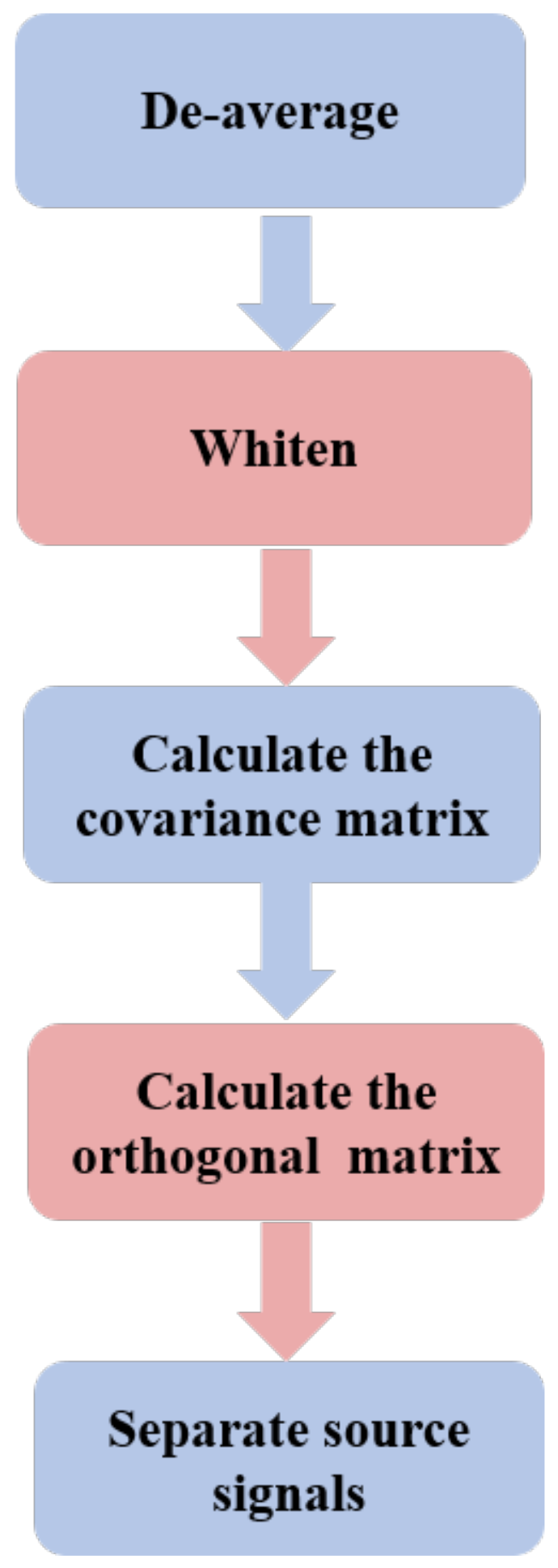
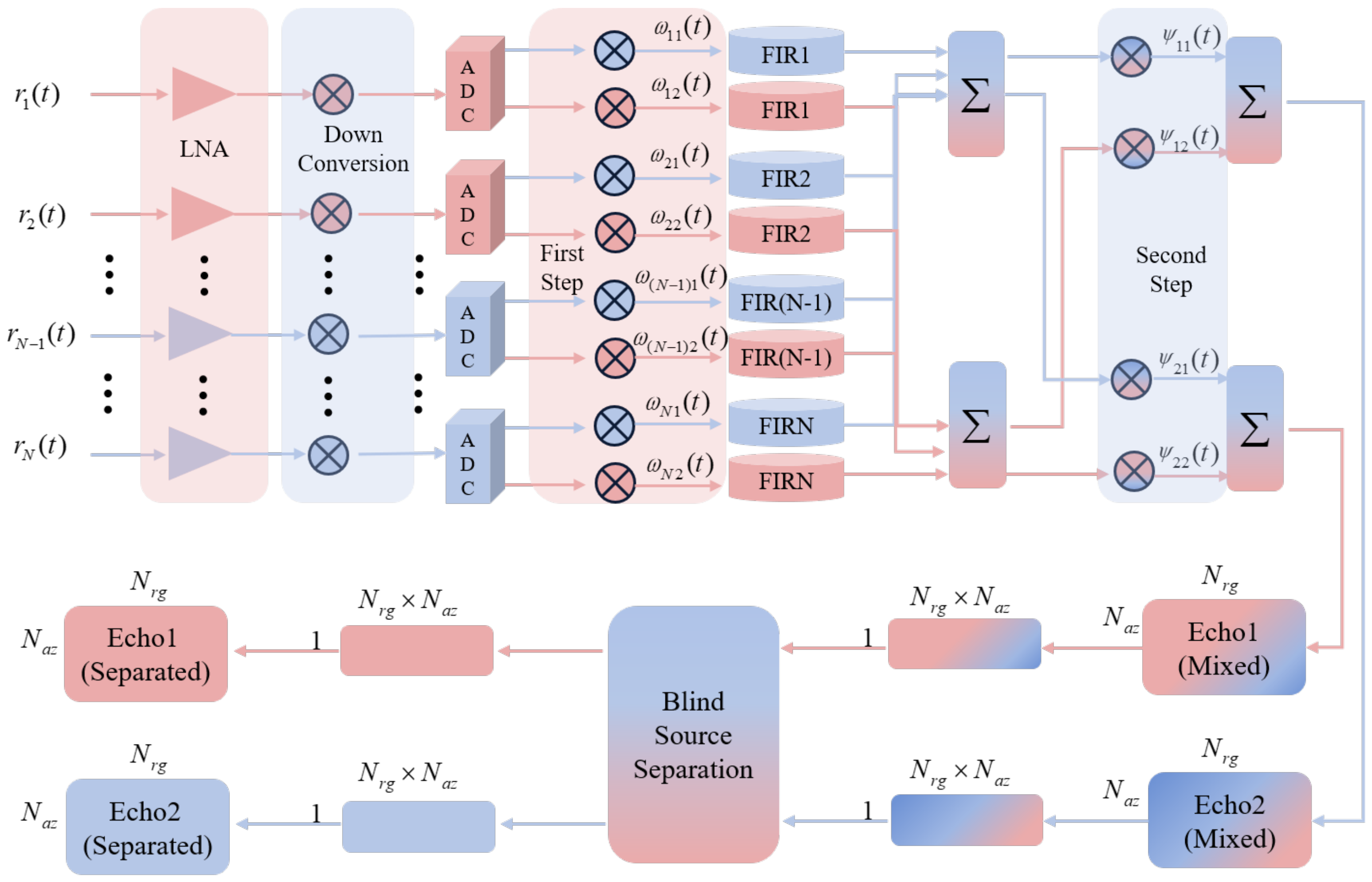
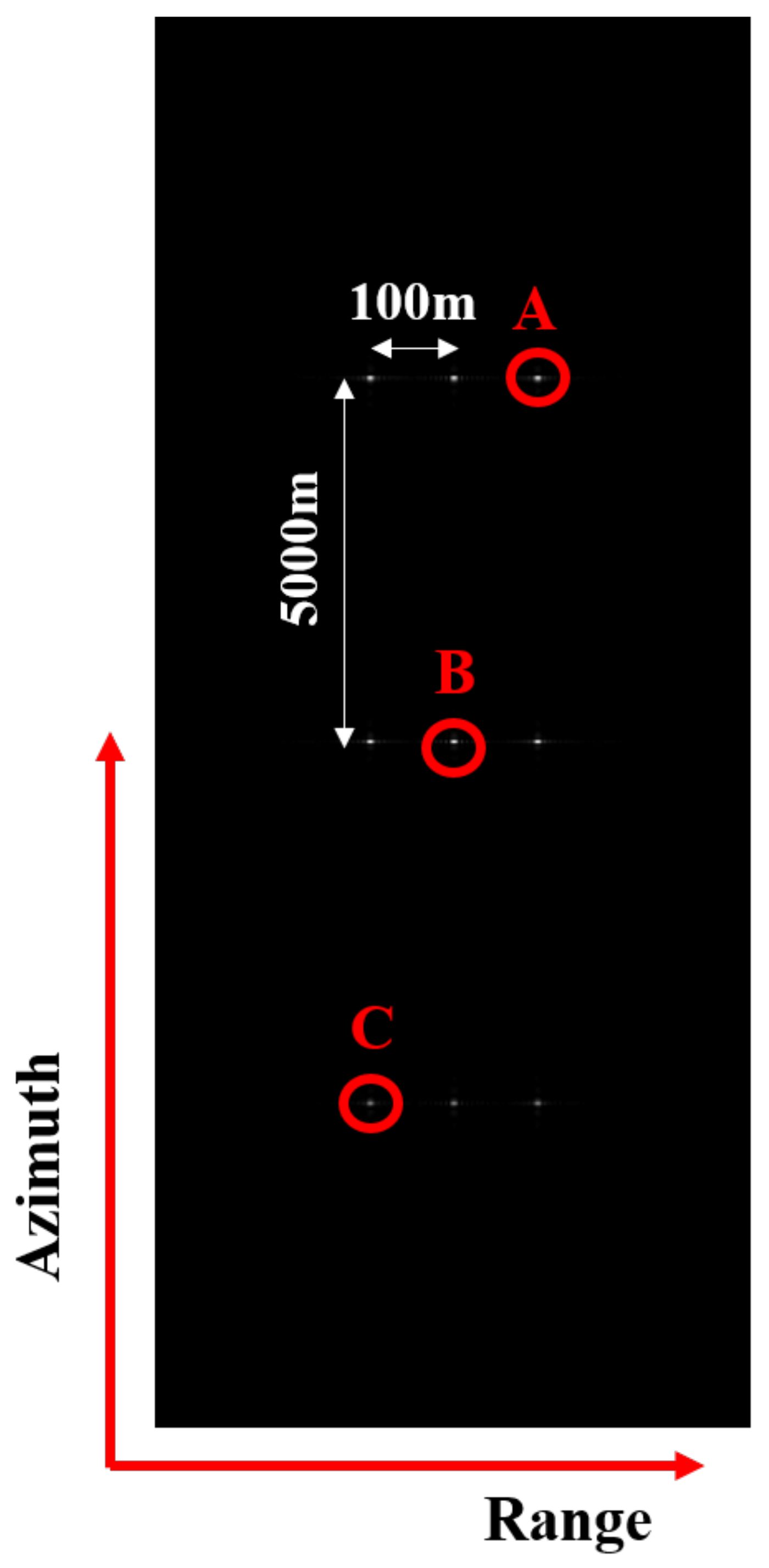
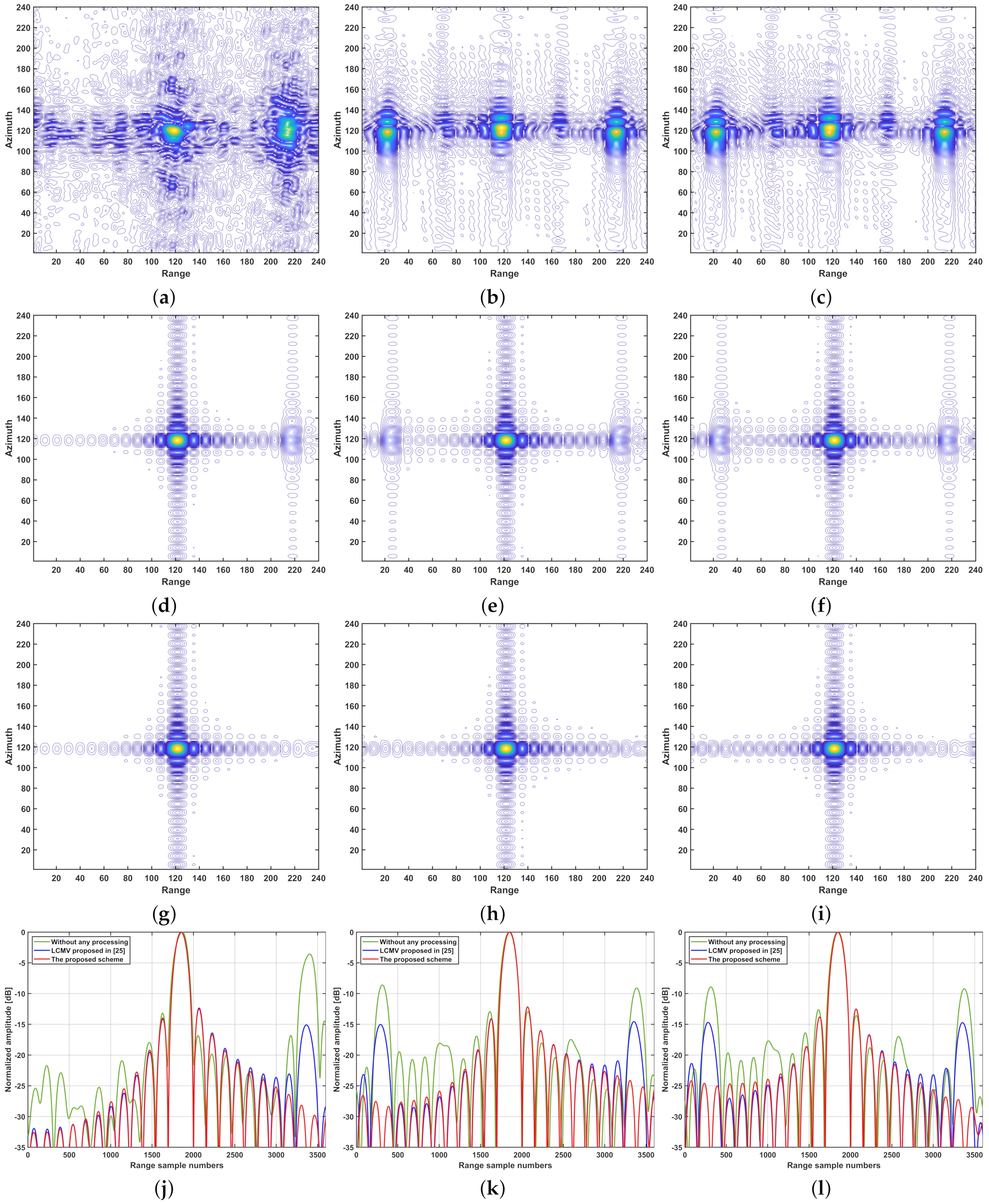
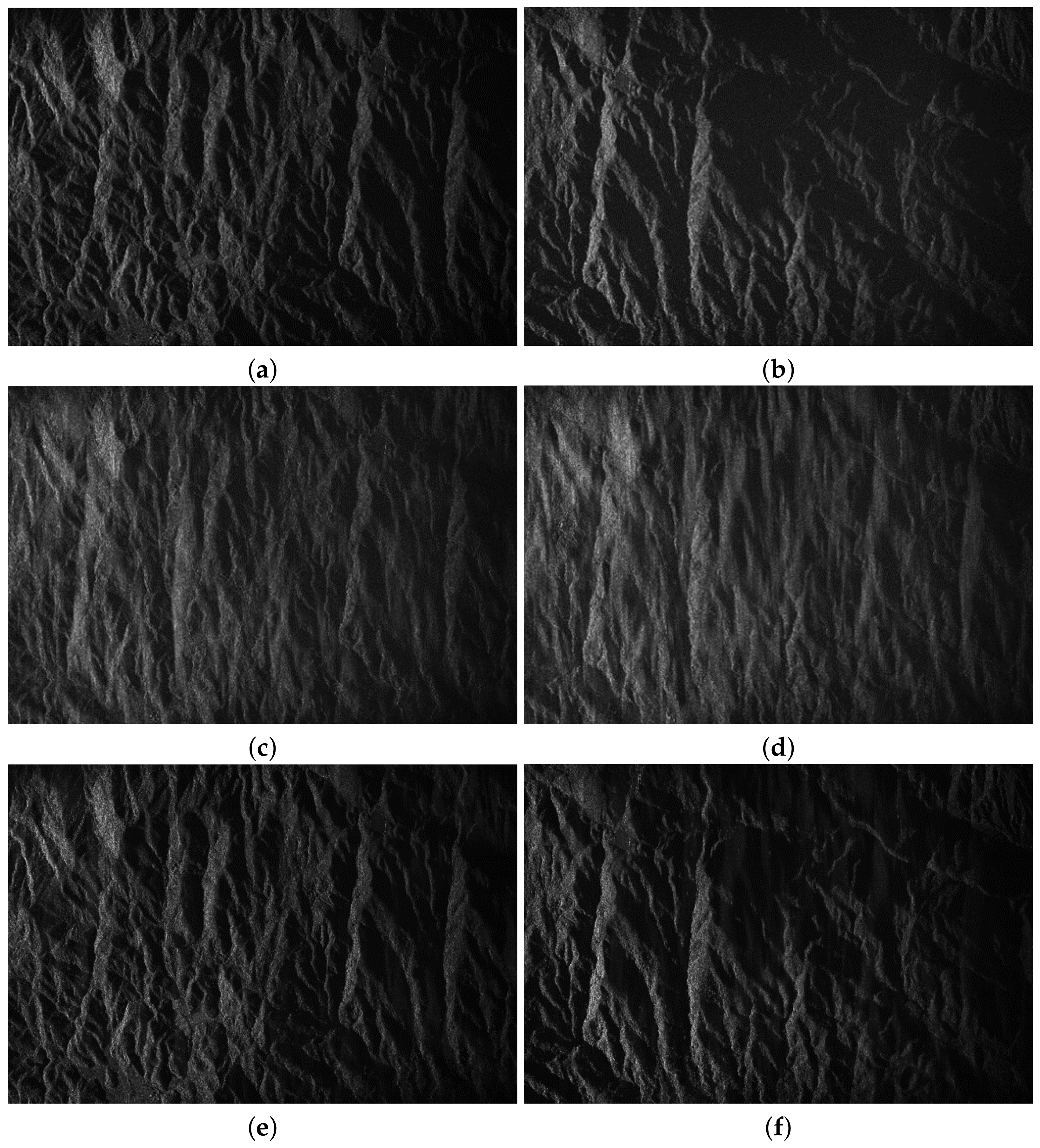
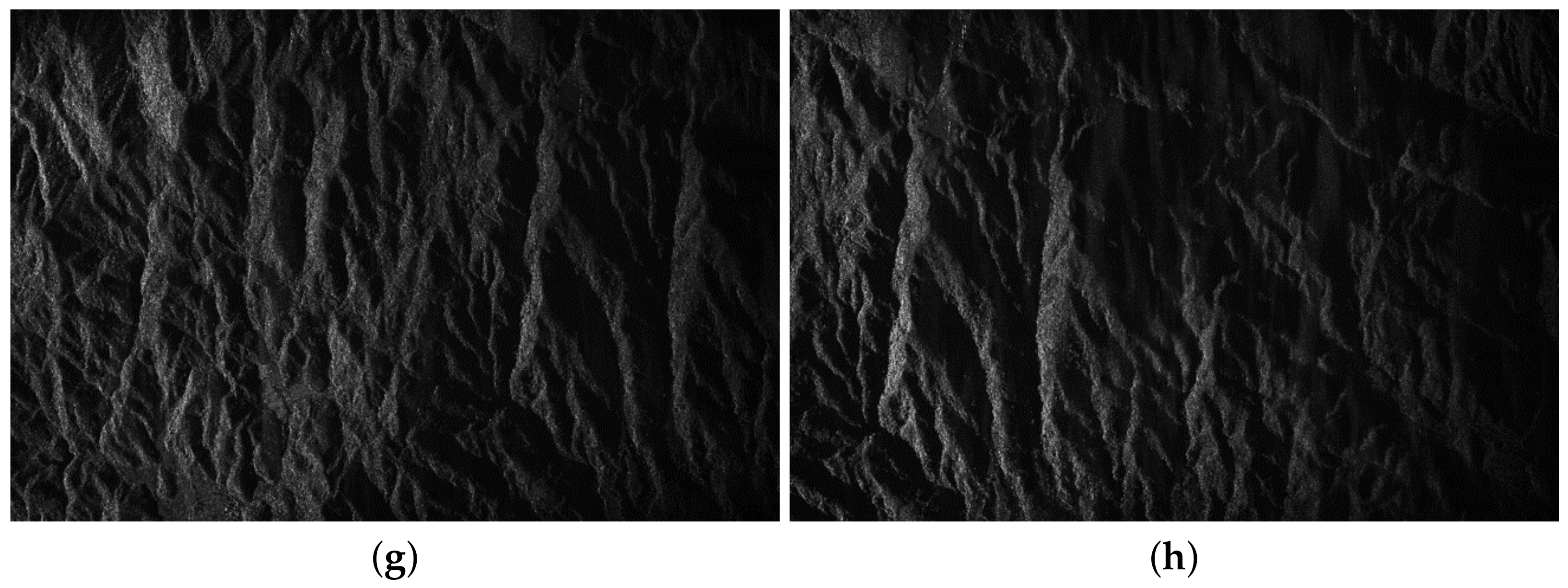

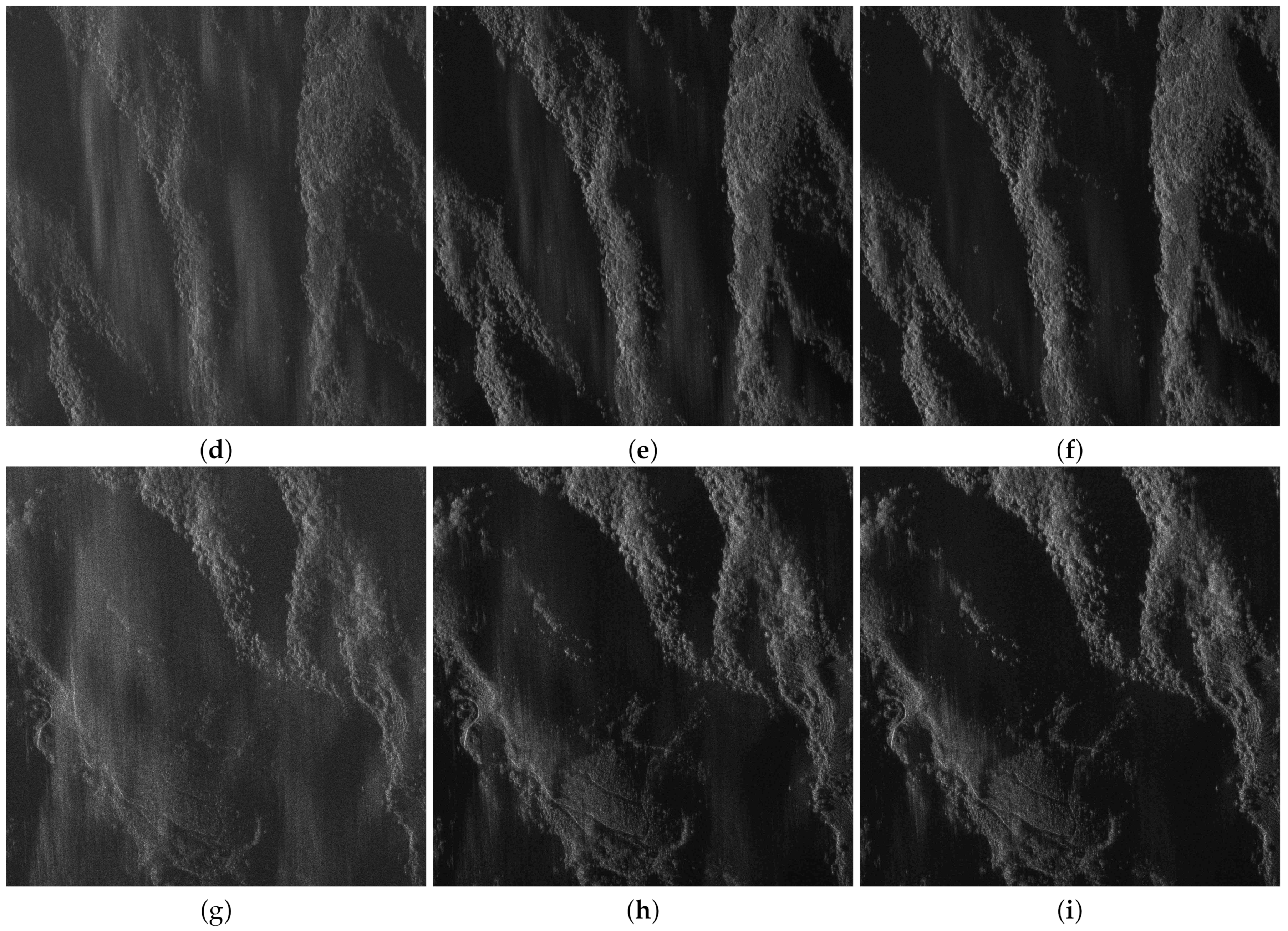
| Parameters | Value |
|---|---|
| Carrier frequency () | 9.6 GHz |
| Orbit height () | 576 km |
| Receiving antenna height () | 0.6 m |
| Parameters | Value |
|---|---|
| Carrier frequency () | 9.65 GHz |
| Orbit height () | 576 km |
| Velocity () | 7559 m/s |
| Number of subapertures in elevation | 16 |
| Sub-pluse number | 2 |
| Pulse duration (T) | 40 μs |
| Signal bandwidth () | 30 MHz |
| Pulse repetition frequency (PRF) | 1275 Hz |
| Height of receive antenna () | 0.2 m |
| Range frequency rate () | 0.75 MHz/μs |
| Elevation error | 2.25 km |
| Target | Range | Azimuth | ||||
|---|---|---|---|---|---|---|
| PSLR (dB) | ISLR (dB) | IRW (m) | PSLR (dB) | ISLR (dB) | IRW (m) | |
| A | ||||||
| B | ||||||
| C | ||||||
| Target | Range | Azimuth | ||||
|---|---|---|---|---|---|---|
| PSLR (dB) | ISLR (dB) | IRW (m) | PSLR (dB) | ISLR (dB) | IRW (m) | |
| A | ||||||
| B | ||||||
| C | ||||||
| Target | Range | Azimuth | ||||
|---|---|---|---|---|---|---|
| PSLR (dB) | ISLR (dB) | IRW (m) | PSLR (dB) | ISLR (dB) | IRW (m) | |
| A | ||||||
| B | ||||||
| C | ||||||
| Parameters | Value |
|---|---|
| Carrier frequency | 9.6 GHz |
| Platform height | 4200 m |
| Platform velocity | 80 m/s |
| Signal bandwidth | 500 MHz |
| Pulse duration | 10 μs |
| Antenna length | 0.496 m |
| Antenna height | 0.30 m |
| Doppler bandwidth | 322 Hz |
| Pulse repetition frequency | 1500–3000 Hz |
| Number of tranmitting channels | 1 |
| Number of receiving channels | 16 |
| IF sampling frequency | 1.2 GHz |
| Looking angle | 65° |
| Acquisition mode | Strip-map |
| Mixed Echo Image | LCMV Proposed in [25] | The Proposed Method | ||||
|---|---|---|---|---|---|---|
| PSNB/dB | SSIM | PSNB/dB | SSIM | PSNB/dB | SSIM | |
| Scene 1 | 20.499 | 0.369 | 27.260 | 0.607 | 28.168 | 0.657 |
| Scene 2 | 21.070 | 0.380 | 27.181 | 0.592 | 28.196 | 0.644 |
| Scene 3 | 16.362 | 0.389 | 23.364 | 0.560 | 24.491 | 0.626 |
Publisher’s Note: MDPI stays neutral with regard to jurisdictional claims in published maps and institutional affiliations. |
© 2022 by the authors. Licensee MDPI, Basel, Switzerland. This article is an open access article distributed under the terms and conditions of the Creative Commons Attribution (CC BY) license (https://creativecommons.org/licenses/by/4.0/).
Share and Cite
Chang, S.; Deng, Y.; Zhang, Y.; Wang, R.; Qiu, J.; Wang, W.; Zhao, Q.; Liu, D. An Advanced Echo Separation Scheme for Space-Time Waveform-Encoding SAR Based on Digital Beamforming and Blind Source Separation. Remote Sens. 2022, 14, 3585. https://doi.org/10.3390/rs14153585
Chang S, Deng Y, Zhang Y, Wang R, Qiu J, Wang W, Zhao Q, Liu D. An Advanced Echo Separation Scheme for Space-Time Waveform-Encoding SAR Based on Digital Beamforming and Blind Source Separation. Remote Sensing. 2022; 14(15):3585. https://doi.org/10.3390/rs14153585
Chicago/Turabian StyleChang, Sheng, Yunkai Deng, Yanyan Zhang, Rongxiang Wang, Jinsong Qiu, Wei Wang, Qingchao Zhao, and Dacheng Liu. 2022. "An Advanced Echo Separation Scheme for Space-Time Waveform-Encoding SAR Based on Digital Beamforming and Blind Source Separation" Remote Sensing 14, no. 15: 3585. https://doi.org/10.3390/rs14153585








